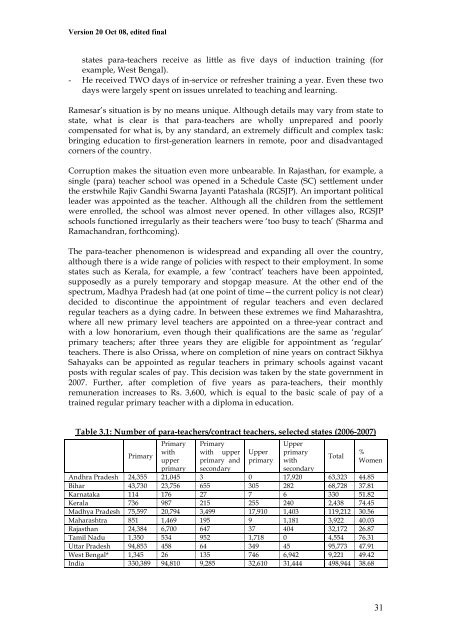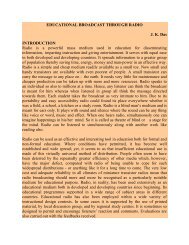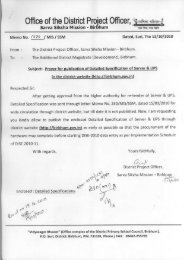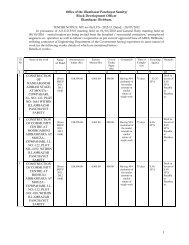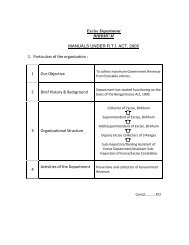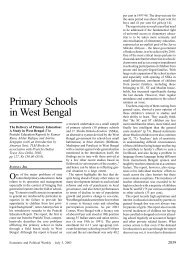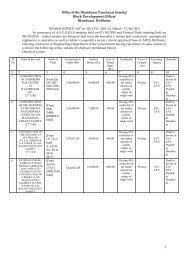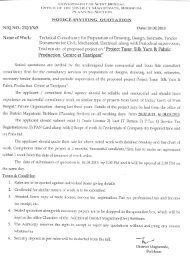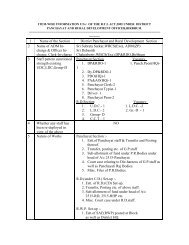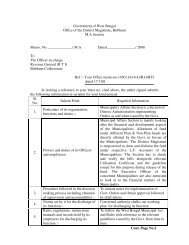primary school teachers the twists and turns of ... - ERU Consultants
primary school teachers the twists and turns of ... - ERU Consultants
primary school teachers the twists and turns of ... - ERU Consultants
Create successful ePaper yourself
Turn your PDF publications into a flip-book with our unique Google optimized e-Paper software.
Version 20 Oct 08, edited finalstates para-<strong>teachers</strong> receive as little as five days <strong>of</strong> induction training (forexample, West Bengal).- He received TWO days <strong>of</strong> in-service or refresher training a year. Even <strong>the</strong>se twodays were largely spent on issues unrelated to teaching <strong>and</strong> learning.Ramesar’s situation is by no means unique. Although details may vary from state tostate, what is clear is that para-<strong>teachers</strong> are wholly unprepared <strong>and</strong> poorlycompensated for what is, by any st<strong>and</strong>ard, an extremely difficult <strong>and</strong> complex task:bringing education to first-generation learners in remote, poor <strong>and</strong> disadvantagedcorners <strong>of</strong> <strong>the</strong> country.Corruption makes <strong>the</strong> situation even more unbearable. In Rajasthan, for example, asingle (para) teacher <strong>school</strong> was opened in a Schedule Caste (SC) settlement under<strong>the</strong> erstwhile Rajiv G<strong>and</strong>hi Swarna Jayanti Patashala (RGSJP). An important politicalleader was appointed as <strong>the</strong> teacher. Although all <strong>the</strong> children from <strong>the</strong> settlementwere enrolled, <strong>the</strong> <strong>school</strong> was almost never opened. In o<strong>the</strong>r villages also, RGSJP<strong>school</strong>s functioned irregularly as <strong>the</strong>ir <strong>teachers</strong> were ‘too busy to teach’ (Sharma <strong>and</strong>Ramach<strong>and</strong>ran, forthcoming).The para-teacher phenomenon is widespread <strong>and</strong> exp<strong>and</strong>ing all over <strong>the</strong> country,although <strong>the</strong>re is a wide range <strong>of</strong> policies with respect to <strong>the</strong>ir employment. In somestates such as Kerala, for example, a few ‘contract’ <strong>teachers</strong> have been appointed,supposedly as a purely temporary <strong>and</strong> stopgap measure. At <strong>the</strong> o<strong>the</strong>r end <strong>of</strong> <strong>the</strong>spectrum, Madhya Pradesh had (at one point <strong>of</strong> time—<strong>the</strong> current policy is not clear)decided to discontinue <strong>the</strong> appointment <strong>of</strong> regular <strong>teachers</strong> <strong>and</strong> even declaredregular <strong>teachers</strong> as a dying cadre. In between <strong>the</strong>se extremes we find Maharashtra,where all new <strong>primary</strong> level <strong>teachers</strong> are appointed on a three-year contract <strong>and</strong>with a low honorarium, even though <strong>the</strong>ir qualifications are <strong>the</strong> same as ‘regular’<strong>primary</strong> <strong>teachers</strong>; after three years <strong>the</strong>y are eligible for appointment as ‘regular’<strong>teachers</strong>. There is also Orissa, where on completion <strong>of</strong> nine years on contract SikhyaSahayaks can be appointed as regular <strong>teachers</strong> in <strong>primary</strong> <strong>school</strong>s against vacantposts with regular scales <strong>of</strong> pay. This decision was taken by <strong>the</strong> state government in2007. Fur<strong>the</strong>r, after completion <strong>of</strong> five years as para-<strong>teachers</strong>, <strong>the</strong>ir monthlyremuneration increases to Rs. 3,600, which is equal to <strong>the</strong> basic scale <strong>of</strong> pay <strong>of</strong> atrained regular <strong>primary</strong> teacher with a diploma in education.Table 3.1: Number <strong>of</strong> para-<strong>teachers</strong>/contract <strong>teachers</strong>, selected states (2006-2007)Primary PrimaryUpperPrimarywith with upper Upper <strong>primary</strong>%Totalupper <strong>primary</strong> <strong>and</strong> <strong>primary</strong> withWomen<strong>primary</strong> secondarysecondaryAndhra Pradesh 24,355 21,045 3 0 17,920 63,323 44.85Bihar 43,730 23,756 655 305 282 68,728 37.81Karnataka 114 176 27 7 6 330 51.82Kerala 736 987 215 255 240 2,438 74.45Madhya Pradesh 75,597 20,794 3,499 17,910 1,403 119,212 30.56Maharashtra 851 1,469 195 9 1,181 3,922 40.03Rajasthan 24,384 6,700 647 37 404 32,172 26.87Tamil Nadu 1,350 534 952 1,718 0 4,554 76.31Uttar Pradesh 94,853 458 64 349 45 95,773 47.91West Bengal* 1,345 26 135 746 6,942 9,221 49.42India 330,389 94,810 9,285 32,610 31,444 498,944 38.6831


